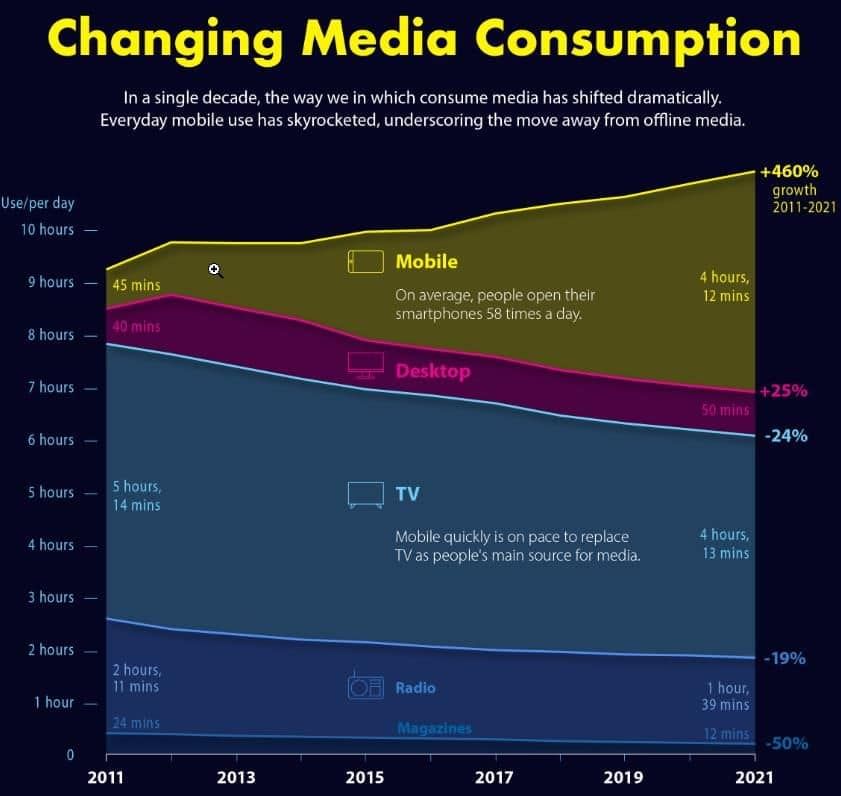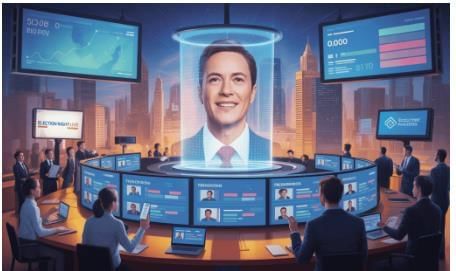The Media Chapter Notes | AP U.S Government and Politics - Grade 12 PDF Download
| Table of contents |

|
| Introduction |

|
| The Media as a Linkage Institution |

|
| Agenda Setting and Evolving Media Technology |

|
| Challenges of the Modern Media Environment |

|
| Polling and the “Horse Race” Effect |

|
Introduction
The media is a cornerstone of American democracy, informing citizens, scrutinizing authority, and linking individuals to their government. As a linkage institution, it facilitates connections between the public and the political process through coverage of elections, policies, and governmental actions. In doing so, it shapes public opinion, influences the national agenda, and impacts political behavior.
The Media as a Linkage Institution
- Historically, Americans depended on newspapers, radio, and television for political information, with these outlets shaping national conversations by selecting which stories to amplify. In the digital age, the variety of news sources has expanded dramatically, and the speed of information delivery has accelerated.
- The First Amendment safeguards press freedom, enabling journalists and media organizations to publish without government censorship. This protection allows the media to act as a watchdog, uncovering corruption, misconduct, or incompetence in government. Some scholars refer to the media as the “Fourth Branch of Government” due to its oversight role.

The media serves several key functions:
- Reporting the news: Media outlets cover events ranging from elections to global crises, keeping the public informed about political developments.
- Shaping the public agenda: By prioritizing certain stories, the media directs national focus to specific issues, such as police reform, economic challenges, or international conflicts.
- Acting as a watchdog: Investigative journalism exposes scandals and holds public officials accountable.
- Connecting citizens to government: By broadcasting debates, speeches, and policy updates, the media keeps the public engaged and informed.
Agenda Setting and Evolving Media Technology
Historical Evolution
- In the early 20th century, investigative journalists, known as muckrakers, exposed corporate greed, political corruption, and social injustices, laying the groundwork for modern watchdog journalism.
- From the 1920s to 1950s, radio and television emerged as dominant news platforms. The major networks—CBS, NBC, and ABC—delivered nightly news to millions of viewers.
- In the 1980s and 1990s, 24-hour cable news networks like CNN, MSNBC, and Fox News introduced narrowcasting, tailoring content to specific ideological audiences.
Note: Narrowcasting refers to media outlets crafting content for targeted ideological groups rather than a broad, general audience.
The Rise of the Internet and Social Media
The digital revolution has reshaped how citizens access political information:
- Traditional print newspapers have seen declining readership and shifted to online platforms.
- Social media platforms, including Twitter, Facebook, and Instagram, have become primary sources for political news.
- Digital-native news outlets like Politico and Axios have gained prominence by employing experienced journalists and providing rapid, in-depth coverage.

Political candidates and officials now use social media to bypass traditional media, communicating directly with the public. For instance, during the 2020 presidential election, candidates leveraged Twitter to address breaking news, raise funds, and shape their public image.
While digital platforms enhance access to information, they also introduce significant challenges.
Challenges of the Modern Media Environment
Despite expanding access to political information, modern media platforms present several issues:
- Misinformation: The internet facilitates the rapid spread of false or misleading information, particularly via social media, as seen during the 2016 U.S. election.
- Echo Chambers: Algorithms on search engines and social media platforms often prioritize content aligning with users’ existing beliefs, creating ideological silos where individuals are exposed only to like-minded perspectives.
- Declining trust: The proliferation of news sources and concerns about bias have led to widespread distrust in mainstream media.
- Sensationalism: Many outlets emphasize drama and controversy to attract viewers and boost ad revenue, often distorting the gravity of political issues.
Note: While digital platforms improve access to political news, they demand greater media literacy—the ability to critically assess sources, verify facts, and recognize bias.
Polling and the “Horse Race” Effect
Media coverage frequently focuses on public opinion polls, particularly during election seasons, influencing perceptions of candidates and issues but risking oversimplification of the democratic process.

The “Horse Race” Mentality
Instead of emphasizing candidates’ policy positions or qualifications, media often prioritizes:
- Which candidate is leading in polls.
- Who performed best in recent debates.
- Which candidate raised the most funds.
- Who is deemed “electable” or gaining traction on social media.
This “horse race” journalism reduces elections to popularity contests, potentially leading voters to prioritize polling trends over substantive policy considerations.
Feedback Loops
Poll-driven coverage can create a self-reinforcing cycle:
- A candidate gains an early lead in polls.
- The media provides them with greater coverage.
- Increased visibility boosts their support due to enhanced name recognition.
Meanwhile, lesser-known but potentially more qualified candidates struggle to gain media attention.
Impact on Trust
Focusing on popularity over policy can undermine public confidence:
- Voters may perceive the media as unfairly influencing elections.
- Citizens may feel disillusioned when qualified candidates receive minimal coverage.
- It reinforces the notion that elections prioritize personality over governance.
Conclusion
The media is a powerful force in American politics, informing citizens, exposing misconduct, and shaping perceptions of candidates, parties, and policies. As technology continues to evolve, the media’s role will adapt, but its influence remains integral to the functioning of American democracy.
Key Terms
- ABC: The American Broadcasting Company (ABC), established in 1943, is a major U.S. television network known for its news, entertainment, and sports programming. It significantly influences public opinion and political discourse through its wide-reaching broadcasts.
- Cable News Networks: Cable news networks are television channels dedicated to delivering news and analysis on politics, current events, and global issues via cable subscriptions. They shape public opinion and political landscapes through continuous 24-hour news cycles and diverse programming.
- Candidate Platforms: Candidate platforms are the policy positions and statements candidates promote during campaigns, outlining their priorities and vision for governance. They guide voter understanding and influence media coverage, shaping public perception.
- Candidate Qualifications: Candidate qualifications are the eligibility criteria, such as age, citizenship, and residency, required to run for office. These standards influence candidates’ appeal and media portrayal in campaigns.
- CBS: The Columbia Broadcasting System (CBS), founded in 1927, is a leading U.S. television network known for its influential news and programming. It shapes cultural narratives and public opinion through its extensive reach.
- CNN: The Cable News Network (CNN), launched in 1980, was the first 24-hour news channel, playing a pivotal role in shaping public opinion and political discourse through continuous news coverage.
- Communication Technologies: Communication technologies are tools and platforms that enable information exchange, revolutionizing news consumption, political engagement, and public discourse in modern society.
- Digital Technologies: Digital technologies encompass electronic systems for generating, storing, and processing data, transforming news creation and consumption through platforms like social media and online outlets.
- Digital Newspapers: Digital newspapers are online versions of traditional print publications, offering real-time updates and multimedia content. They enhance news accessibility and influence journalism practices in the digital era.
- Election Outcome: Election outcomes are the final results of electoral processes, determining winners and shaping future political dynamics, party strategies, and policy decisions through media interpretation.
- Facebook: Launched in 2004, Facebook is a social media platform enabling users to connect and share content, significantly shaping news consumption and political discourse in the digital age.
- First Amendment of the Constitution: The First Amendment guarantees freedoms of speech, press, religion, assembly, and petition, protecting individual liberties and enabling the media to inform and hold government accountable.
- Fourth Branch of Government: The term “Fourth Branch of Government” describes the media’s role in shaping policy and public opinion, acting as a check on the legislative, executive, and judicial branches.
- Fox News Website: The Fox News Website provides news and opinion content with a conservative perspective, influencing political discourse and public opinion among a significant portion of the U.S. audience.
- Fox News: Launched in 1996, Fox News is a major cable news channel known for its conservative commentary, shaping political discourse and public opinion among right-leaning viewers.
- Industrial Age: The Industrial Age, spanning the late 18th to early 20th centuries, brought transformative changes in production and society, influencing media development through mass communication advancements.
- Instagram: Instagram, a social media platform for sharing photos and videos, shapes public opinion and political engagement, particularly among younger audiences, through visual storytelling.
- Internet as Primary Source of Political News: The internet, including social media and news websites, has become a primary source for political information, transforming news consumption and influencing public opinion.
- Internet: The internet is a global network of computers enabling information sharing through websites, email, and social media, fundamentally shaping modern news dissemination and public engagement.
- Investigative Reporting: Investigative reporting involves in-depth journalism to uncover hidden facts, corruption, or misconduct, fostering transparency and accountability in government and society.
- Linkage Institution: Linkage institutions, such as the media, political parties, and interest groups, connect citizens to government, facilitating communication, shaping public opinion, and promoting political participation.
- Machine Learning: Machine learning, a subset of artificial intelligence, enables systems to analyze data and make decisions, enhancing media content personalization and predictive analytics.
- Magazines: Magazines are periodicals offering articles and advertisements on specific topics, shaping public opinion through in-depth coverage of politics, culture, and other issues.
- Media and Polling Results: Media disseminates information through various channels, while polling results provide insights into public opinion, influencing political campaigns and public discourse.
- Media and Political Information: Media delivers political news and information through television, newspapers, and digital platforms, shaping voter engagement and holding leaders accountable.
- Mobile Devices: Mobile devices are portable tools enabling on-the-go access to information, significantly influencing how individuals consume media and engage with news.
- MSNBC: Launched in 1996, MSNBC is a cable news network offering progressive commentary, shaping political discourse and public opinion among left-leaning audiences.
- Muckrakers: Muckrakers were early 20th-century journalists who exposed corruption and social injustices, driving reforms and shaping public opinion during the Progressive Era.
- Narrowcasting: Narrowcasting involves tailoring media content to specific ideological audiences, enhancing engagement by delivering targeted information and opinions.
- NBC: The National Broadcasting Company (NBC), founded in 1926, is a major U.S. television network influencing public opinion through its news, entertainment, and sports programming.
- Newspapers: Newspapers are printed publications delivering news and opinions, historically shaping public opinion and serving as a key source of political information.
- Online News Websites: Online news websites provide digital news content with real-time updates and multimedia, transforming news consumption and influencing political discourse.
- Policy Agenda: A policy agenda comprises issues prioritized by policymakers, shaped by media coverage, public concerns, and political actors, driving legislative action.
- Political Fraud: Political fraud involves deceptive practices to mislead voters or manipulate elections, undermining the integrity of the political process through misinformation or corruption.
- Polling Results: Polling results are survey data reflecting public opinion on issues or candidates, shaping political campaigns, media coverage, and public discourse.
- Popularity Contests: Popularity contests describe elections where media focus on candidate image and charisma, often overshadowing policy substance and qualifications.
- Print Newspapers: Print newspapers are physical publications delivering news and opinions, historically shaping public opinion and informing citizens about events.
- Radio: Radio uses electromagnetic waves to transmit audio content, shaping public opinion and delivering news efficiently since the early 20th century.
- Radio Broadcasts: Radio broadcasts transmit audio content to wide audiences, influencing public opinion and cultural exchange through news and entertainment.
- Search Algorithms: Search algorithms retrieve information from digital databases, influencing online content visibility and shaping public opinion in the media landscape.
- Scandals: Scandals involve significant wrongdoing, often exposed by media, shaping public perception and influencing political outcomes through coverage of misconduct.
- Self-fulfilling Prophecy: A self-fulfilling prophecy is an expectation that influences behavior to make itself true, particularly evident in media-driven narratives shaping public opinion.
- Social Media: Social media platforms enable real-time content sharing and communication, shaping political discourse and engagement through direct interaction.
- Television: Television transmits visual and audio content, significantly influencing public opinion and political communication through news and entertainment programming.
- Traditional News Media: Traditional news media, including newspapers, television, and radio, historically shape public opinion and political discourse through mass communication.
- Twitter: Twitter, a platform for short messages, facilitates real-time political discourse and direct interaction between public figures and citizens.
- TV Broadcasts: TV broadcasts deliver programs and news to wide audiences, shaping public opinion and cultural norms through visual storytelling.
- TV News: TV news delivers current events and political information, prioritizing visuals to engage viewers and influence public opinion.
- Watergate: The Watergate scandal of the 1970s involved a break-in at the Democratic National Committee and a cover-up, eroding public trust and highlighting media’s role in exposing misconduct.
FAQs on The Media Chapter Notes - AP U.S Government and Politics - Grade 12
| 1. What is the role of media as a linkage institution in politics? |  |
| 2. How has investigative journalism evolved over the years? |  |
| 3. What impact has the rise of the internet and social media had on political information access? |  |
| 4. How do media and polling influence elections? |  |
| 5. What are some key terms related to media and politics that students should review? |  |



















